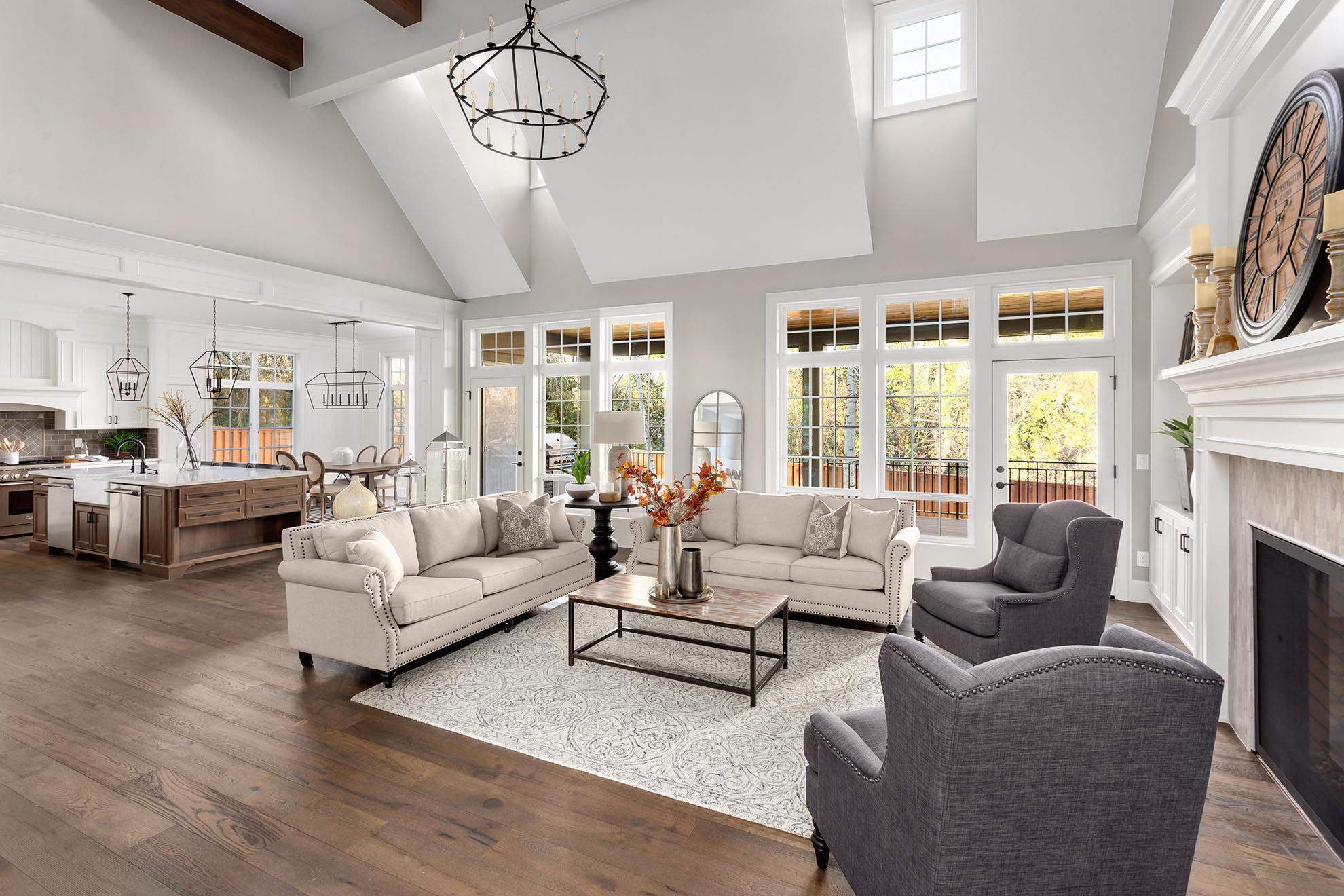Article courtesy of Forbes.There are countless articles and blog posts focusing on which home improvements will yield the greatest financial return on investment. But there’s another way to look at the ROI conversation: Which home improvements offer the best potential for improving your personal well-being. Those include the five facets of wellness design: health and fitness, safety and security, accessibility, functionality, and comfort and joy. Given the increasing importance of wellness to homebuyers, they might also add to the salability of your home when you do choose to put it on the market.
“It’s understandable why everyone is concerned about maintaining a healthy home,” comments Caroline Danielson, director of showrooms for upscale chain retailer Ferguson Bath, Kitchen & Lighting Gallery, adding that with recent research being made more widely available on the links between home and health, “It is no surprise that many homeowners are considering renovations that improve more than the look of a home.” These can all help homeowners clean faster, cook smarter and rest easier, she notes.
Technology
Indoor air quality systems can detect radon and other silent, odorless toxins in your home.
PHOTO COURTESY OF PHOTO COURTESY OF AIRTHINGS/GREENROOM // WELLNESS BY DESIGN (TILLER PRESS, 2020, © J. GOLD)
The topic of technology for wellness – including air and water quality, tunable lighting, and acoustic comfort – are all gaining popularity. “The pandemic brought the interest level up even higher,” observes Josh Christian, CEO of the Home Technology Association trade organization. Covid made the need for healthy indoor air urgent. Wildfires add to that urgency, with their smoke and ash infiltrating homes in nearby regions, and pollution is an ongoing issue in some areas.
“In-room portable air purifiers have exploded in popularity,” Christian shares, “though many homeowners aren’t aware that their whole home can have pure air with specialized air filtration systems.” These installations can be done through home technology integrators, he adds. “A good system can improve the safety of people in a home.” Real-time monitoring capabilities for water quality are not as advanced, Christian notes, “but when water filtration is part of a smart home system, there is extensive testing done up front to identify the best solution for the specific location needs.”
Materials
Porcelain slab creates a healthy marble-look countertop without marble’s fragility or need for … [+]
FONDOVALLE/CERAMICS OF ITALY MEMBER COMPANY
This is a challenging topic, because so many products offer both wellness benefits like softness underfoot, flame retardants and antimicrobial protection, while unfortunately introducing chemicals that can be damaging to our bodies. “The chemicals that help make a product flexible, light, sturdy have major side effects on our health including cancers, decreased fertility in both men and women and other hormonal related health issues, thyroid disease and elevated cholesterol,” cautions Alison Mears, director of the Healthy Materials Lab at Parsons University.
Looking at one surfacing material you’ll find in every home: countertops, Mears suggests porcelain slab manufactured without lead or asbestos, and natural materials like wood and granite (that may require more upkeep). For flooring, she warns against one of the most popular materials on the market today: luxury vinyl tile. Toxic dioxins are released during their manufacture that an persist in the body for years after exposure, she reveals. “With links to cancer, reproductive disorders, and hormone disruption, they have been called the most toxic man-made substance ever created. [Vinyl] floors also contain phthalates, which are endocrine disruptors. It is important [to] seek healthier alternatives in linoleum, cork, natural rubber, or bio-based materials that avoid any inclusion of vinyl,” she recommends. Options Mears prefer include floating engineered hardwoods with natural finish, ceramic tiles without heavy metal glazes, linoleum and polished concrete with a nontoxic finish.
When it comes to cabinetry, carcinogenic urea formaldehyde is a major element to avoid, Mears advises. NAUF (no added urea formaldehyde) products that reduce its use are a safer option. You’ll also want a cabinet with nontoxic finishes.
Appliances
Clothing refreshers have become popular laundry appliances for sanitizing clothing, bedding and … [+]
PHOTO COURTESY OF LG ELECTRONICS // WELLNESS BY DESIGN (TILLER PRESS, 2020) (C) J. GOLD
Danielson points to appliances as one category where technology has always been a trending topic; lately it’s been heavily focused on wellness. “From steam ovens that allow homeowners to effortlessly prepare healthy meals to high-capacity, sanitizing dishwashers with settings to eliminate 99.999% of food soil bacteria by adding a high-heat final rinse to sanitize dishes, appliance technology is becoming more sophisticated.”
She points to a new category too: indoor plant growers. “Herb growing cabinets have captured homeowners’ imaginations,” the retailer observes. “Imagine making a salad with farm-fresh micro greens or cooking a meal and having the ability to use fresh herbs available right in the kitchen. All organic greens offer superior flavor and the best nutrition.”
Another category Danielson notes is the clothing refresher, which adds convenience to time-pressed homeowners. These allow homeowners to care for delicates without using harsh chemicals common in dry cleaning, she notes. They can also safely sanitize bedding between guests and children’s stuffed animals.
Fixtures and Faucets
Steam showers are popular, healthy bathroom upgrades.
PHOTO COURTESY OF THERMASOL AVAILABLE FERGUSON BATH, KITCHEN & LIGHTING GALLERY
“With the push for better health and wellness, home fixtures and faucets are now a great way to improve your overall well-being,” Danielson shares, pointing to the latest in water filtration systems and steam showers. The former will help ensure that the household is drinking clean water daily. “In addition to filtering out contaminants like lead or chlorine, these systems can also reduce smells and tastes that make your drinking water less desirable,” she says.
“Steam showers allow users to relax while enjoying aromatherapy benefits. They are especially beneficial for those with respiratory conditions or muscle tension as the warm steam helps open airways and decreases muscle soreness,” Danielson comments.
“The wetroom is seeing a surge in demand due to its frameless, zero entry design concept that creates an open and spacious atmosphere.” These spaces that place a tub within an oversized shower enclosure provide aesthetic appeal and greater accessibility, but as the Ferguson executive notes, their “increased popularity is largely due to their ability to keep germs from hiding in hard-to-reach places and allows for easy maintenance and cleaning.”
In general, she is seeing an increased focus on hygiene-enhancing fixtures. “Touchless faucets can help limit exposure to dirt and bacteria, while providing users with convenience and ease,” she notes.
Lighting
New technology in a fan-light fixture can kill pathogens.
PHOTO COURTESY OF BIG ASS FANS / HAIKU
The pandemic has definitely had an impact on lighting. “Homeowners clean the air with a ceiling fan that cools and circulates the air using ultraviolet technology, verified through independent laboratory testing to kill 99.99% of SARS-CoV-2 (causes COVID-19) and other airborne pathogens while safely neutralizing allergens, odors, and fumes,” Danielson says.
She also points to lighted exhaust fans as problem blockers: “By removing moisture and odors effectively with a lighted exhaust fan, homeowners can prevent mold, bacteria and fungi growth on surfaces in bathrooms, laundry rooms or other humidity-prone environments.”
Danielson is bullish on preset dimmers as a great new lighting option for wellness, she says, noting they “make it easy to adjust your lighting levels depending on the time of day and can be set to ensure you have enough light without causing eye strain or discomfort.” This is a particular benefit to older adults for both safety and comfort. “This age-friendly feature ensures that you don’t have to worry about straining your eyes when trying to find something in a dark area or dealing with overly bright lights when going outside at night.”
Circadian lighting, also called tunable lighting or human centric lighting, is another way to boost wellness in this category. Many more manufacturers are offering these solutions now and the category has massively grown in the past four years, HTA’s Christian observes. This has also led to lower prices and more availability, but you get what you pay for when it comes to this technology, he warns.
Outdoor dark sky lighting is another new innovation that helps the health of your household and the planet. Health-wise, it reduces blue light emitted from LED bulbs, linked to sleep disruption in some individuals, Danielson comments.
Chromotherapy is another great innovation, often used in primary bathrooms. “This type of lighting uses certain colors to promote relaxation and healing properties in the body,” the Ferguson executive says. “Using different shades of blue or purple, you can create a calming environment that will reduce stress and anxiety while cleansing yourself or taking a warm bath or shower.”
Wellness Tips from the Pros
Professionally-installed smart home technology systems can improve the wellness and resale potential … [+]
COURTESY OF HOME TECHNOLOGY ASSOCIATION / CRESTRON
“When looking to upgrade your home in a way that promotes health and wellness, it’s important to visit reputable showrooms and work with a designer or contractor you trust,” Danielson recommends. “There are special certifications for wellness and universal design. For example, a certified universal design professional will help homeowners create an environment that emphasizes comfort and safety for all ages and abilities. Homeowners can ask the designer about their certification and determine if their specialty matches their wellness goals.”
Christian highlights the importance of working with professionals too. “Homeowners, architects, interior designers, and builders need a qualified home technology professional to consult about the latest in wellness tech,” he recommends and this consultation needs to start at the beginning of the planning process.
Mears keeps it simple: “Ask the questions: What is it made of? Do I need it?”
Last Words
Induction is a healthier and more eco-conscious cooking technology than gas.
MIELE AVAILABLE THROUGH FERGUSON BATH, KITCHEN & LIGHTING GALLERY
One of the happy coincidences of climate change action is that can create healthier home interiors too. This urgency is driving local, state and federal legislation and incentives to reduce fossil fuel consumption, as Mears points out. Since their byproducts go into surfacing materials like LVT, cutting back on their use could lead to healthier homes too. Cutting greenhouse-causing emissions helps drive incentives to swap gas cooktops with induction models. What’s healthy for the planet can be healthy for you and your home.
You don’t have to be a billionaire to make healthy home changes either. “What we are learning is that affordability varies a lot based on budget, region and creativity. And a lot of what we can do to decrease costs or direct the budget to better materials is to change our practice,” Mears shares. She also notes that a simpler material palette might allow for higher volume in selected products and possibly offer better pricing. Being strategic with choices – e.g., a one-coat paint and primer combo – can reduce labor costs and, of course, working with a wellness designer who has relationships with healthy products manufacturers and flexible margins can save the homeowner money.








